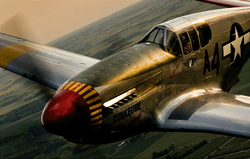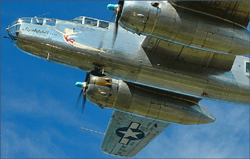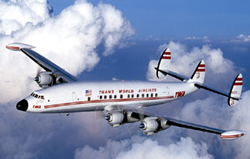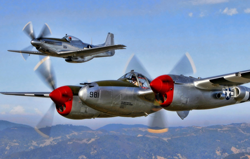Flying Fortress

Manufacturer: The Boeing Company
Primary Role: Heavy Bomber
- Description:
- Specifications:
The Boeing B-17 Flying Fortress was first seen on 28 Jul 1935 as E. Gifford Emery and Edward Curtis Wells' Boeing Model 299, flown by test pilot Les Tower. It was designed as a response to the United States Army Air Corps' 1934 demand for a multi-engined bomber, but Boeing had over-done it: the four-engined bomber was so expensive that the Army instead went with the two-engined Douglas B-18 Bolo. The evaluation, though tainted with a fatal accident, impressed some top brass regardless. Through a legal loophole, the USAAC ordered 13 B-17 bombers for testing on 17 Jan 1936. Between that time and the opening of the Pacific War in 1941, fewer than 200 B-17 bombers entered service with the USAAC. Some of the early production bombers went to the British Royal Air Force which began the European War without heavy bombers. In early 1940, 20 B-17 bombers, redesignated Fortress I bombers by the RAF, were transferred to the RAF. Their first operation was against the German Kriegsmarine's facilities at Wilhelmshaven on 8 Jul 1941, and their performance left much to be desired as bombs missed their targets and machine guns froze at the high altitude. While these early B-17 bombers were being relegated to reconnaissance and patrol roles, the experiences shared by the British crews helped Boeing tweak the design of later models; mainly, the British crews expressed the need for these bombers to carry larger bomb loads and better aiming equipment.
The United States entered the war in Dec 1941, and from the start she began building up air forces in Europe. The first 18 B-17E bombers arrived to equip the US 8th Air Force units in mid-1942, and flew their first mission against French rail yards on 17 Aug 1942. With the newly devised Norden Bombsight, this mission was much more successful than the British experience earlier in the European War.
The American direct involvement in war increased production of B-17 bombers dramatically; in fact, they are often considered the first mass-produced modern aircraft. Before the advent of long-range fighter escorts, B-17 bombers flew in box formations so that their machine guns could provide overlapping fields of fire to protect each other, though at a sacrifice of rigidity of flight paths, which led to increased dangers from ground-based anti-aircraft guns. These bombers, after many rounds of improvements, were now known for their extreme durability. Many stories were told where major sections of the bombers, such as the tail fin, nearly destroyed but the crews still made their ways home safely.
During WW2, 26 B-17 bomber groups served in Britain and 6 groups served in Italy. Beginning in 1943, they began a carpet bombing campaign against German targets that targeted German industries. Initially an alarming number of B-17 bombers were lost, but as the war went on, the depleting capabilities of German air defense made the bombing campaigns more effective. Many accused the Western Allies of conducting terror bombing during WW2, and many of the alleged terror bombing missions were conducted with B-17 bombers. On 15 Feb 1945, as part of the aerial operation against the German city of Dresden, 311 B-17 bombers dropped 771 tons of bombs, contributing to the killing of 25,000 people committed by both American and British bombers.
Some B-17 bombers crash-landed or were forced down on German soil, and about 40 of them were put into service by the Luftwaffe. They were designated Do 200 and were used in reconnaissance operations. A few of them kept their Allied markings and were sent to infiltrate Allied B-17 formations to report their position and altitude; initially successful, Allied airmen soon developed methods to challenge unidentified aircraft that tried to join their formations.
Several B-17 bombers were also taken by the Russians who flew them in combat missions despite having little experience with them. Russian opinion toward the B-17 design was generally favorable. Some remained in Russian service until 1948.
Five bomber groups of the US 5th Air Force operated B-17 bombers in the Pacific Theater, with a peak of 168 bombers in Sep 1942. After some time of ineffective high altitude bombing, a tactic of releasing bombs at a very low altitude took shape. Nicknamed "skip bombing", the bomb released struck the water at a shallow angle, bouncing into the sides of targeted ships. The technique of skip bombing scored several sinkings.
When WW2 ended, a total of 12,700 B-17 bombers were built. Peak US Army Air Force inventory, in Aug 1944, was 4,574 worldwide. Besides Boeing, Douglas and Lockheed (via subsidiary Vega) also contributed to that total. After the war General Carl Spaatz commented that "[w]ithout the B-17, we might have lost the war."
After the war, some B-17 bombers made their way to Israel via the black market, some were treasured by collectors in form of museums, while most of them were melted down for scrap. The most famous of the surviving B-17 is arguably the 25-mission veteran of European Theater Memphis Belle, which is now at National Museum of the United States Air Force near Dayton, Ohio, United States for restoration and display in the near future.
Length: 9.99 m
Height: 5.82 m
Powerplant: 4 Wright R-1820-97 \\\\\\\'Cyclone\\\\\\\' turbosupercharged
Cruising Speed: 293 km/h
Maximum Speed: 462 km/h



